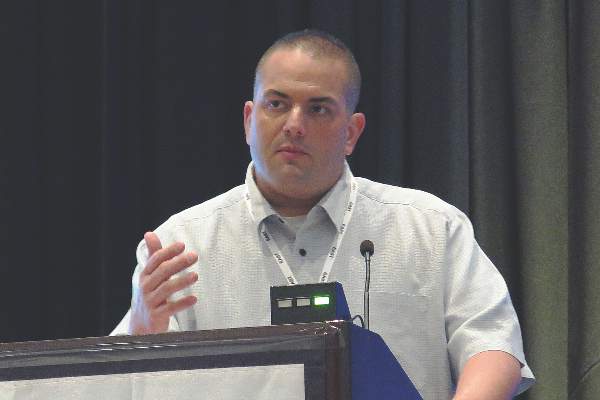User login
LAKE BUENA VISTA, FLA. – Modifying the Centers for Disease Control and Prevention’s outpatient fall prevention program STEADI for inpatient use did not prevent further falls in elderly patients hospitalized for fall injuries.
The intervention was associated, however, with a “clear reduction in median length of stay and hospital charges,” Dr. Alexander Eastman, M.P.H., said at the annual scientific assembly of the Eastern Association for the Surgery of Trauma.
STEADI(Stopping Elderly Accidents, Deaths and Injuries) is a CDC–funded program. It has six core domains – fall history, medical conditions, medications, gait/balance, vision limitation, and postural hypotension – and includes standardized gait and balance assessments and a fall-prevention checklist.
Dr. Eastman and other members of a multidisciplinary team at the University of Texas Southwestern Medical Center in Dallas used the same checklist principle to create a modified version of the STEADI program (mSTEADI) for inpatient use. Their patient assessment was associated with delivery of therapeutic interventions, and the gait and posture testing and therapies were adapted for use with injured patients.
Data were then prospectively collected for 1 year from 218 patients, aged older than 65 years, who were admitted for falls at the level 1 trauma center and enrolled in the mSTEADI program. Their results were compared with data from 196 historical controls from the same period the year before mSTEADI was introduced. The two groups were well matched with respect to median age (77 years vs. 76 years); mean Injury Severity Score (12.1 vs. 11.8); and Abbreviated Injury Scale (AIS) head, face, chest, or abdomen scores. mSTEADI patients had a slightly higher mean AIS extremity score (2.7 vs. 2.5; P value = .014).
After a year, however, the mSTEADI group and the historical controls had the same in-house fall rate, 4.1%. The fall recidivism rate was 2.1% for the mSTEADI group and 2.8% for the controls, an insignificant difference, Dr. Eastman said.
The mSTEADI group, however, was discharged a day earlier (5 days vs. 6 days; P <.01), was more likely to be discharged directly home (54.5% vs. 46.8%; P <.01), and had lower overall hospital charges ($45,538 vs. $60,585; P = .02).
Limitations of the study were the use of retrospective controls and the very real possibility of selection bias in a group receiving intensive assessment and therapy, Dr. Eastman said. Discussant Dr. Stephanie Bonne of Washington University, St. Louis, asked whether the researchers were confident they captured all subsequent falls when calculating recidivism in such a large urban setting and whether the findings of shorter hospital stay and more discharges home would prompt them to recommend mSTEADI for enhancing rehabilitation protocols rather than for preventing repeated falls.
Dr. Eastman said that the combination of medical and emergency medical services records probably captured geriatric patients returning to the hospital with an injury from a fall since Southwestern is the EMS medical director for Dallas and 15 surrounding municipalities.
“As far as the decreased length of stay, I think there’s no question that increased focus on your rehabilitation efforts results in this unintended benefit of getting more patients home,” he added. “That’s a very real, tangible benefit to this program, but I’m not sure you have to incorporate all the other stuff that the mSTEADI program brings rather than breaking out just those specific portions of the program that are rehab focused and then really going out and studying in-hospital falls and fall recidivists to see what other phases are potential targets for intervention.”
Because the translation of the STEADI program to mSTEADI may have missed “some intangible associated with in-house falls,” an additional study of inpatient falls (iSTEADI) is being planned, as are home visits by Dallas paramedics to assess fall risk for every fall patient discharged from their institution, Dr. Eastman said.
LAKE BUENA VISTA, FLA. – Modifying the Centers for Disease Control and Prevention’s outpatient fall prevention program STEADI for inpatient use did not prevent further falls in elderly patients hospitalized for fall injuries.
The intervention was associated, however, with a “clear reduction in median length of stay and hospital charges,” Dr. Alexander Eastman, M.P.H., said at the annual scientific assembly of the Eastern Association for the Surgery of Trauma.
STEADI(Stopping Elderly Accidents, Deaths and Injuries) is a CDC–funded program. It has six core domains – fall history, medical conditions, medications, gait/balance, vision limitation, and postural hypotension – and includes standardized gait and balance assessments and a fall-prevention checklist.
Dr. Eastman and other members of a multidisciplinary team at the University of Texas Southwestern Medical Center in Dallas used the same checklist principle to create a modified version of the STEADI program (mSTEADI) for inpatient use. Their patient assessment was associated with delivery of therapeutic interventions, and the gait and posture testing and therapies were adapted for use with injured patients.
Data were then prospectively collected for 1 year from 218 patients, aged older than 65 years, who were admitted for falls at the level 1 trauma center and enrolled in the mSTEADI program. Their results were compared with data from 196 historical controls from the same period the year before mSTEADI was introduced. The two groups were well matched with respect to median age (77 years vs. 76 years); mean Injury Severity Score (12.1 vs. 11.8); and Abbreviated Injury Scale (AIS) head, face, chest, or abdomen scores. mSTEADI patients had a slightly higher mean AIS extremity score (2.7 vs. 2.5; P value = .014).
After a year, however, the mSTEADI group and the historical controls had the same in-house fall rate, 4.1%. The fall recidivism rate was 2.1% for the mSTEADI group and 2.8% for the controls, an insignificant difference, Dr. Eastman said.
The mSTEADI group, however, was discharged a day earlier (5 days vs. 6 days; P <.01), was more likely to be discharged directly home (54.5% vs. 46.8%; P <.01), and had lower overall hospital charges ($45,538 vs. $60,585; P = .02).
Limitations of the study were the use of retrospective controls and the very real possibility of selection bias in a group receiving intensive assessment and therapy, Dr. Eastman said. Discussant Dr. Stephanie Bonne of Washington University, St. Louis, asked whether the researchers were confident they captured all subsequent falls when calculating recidivism in such a large urban setting and whether the findings of shorter hospital stay and more discharges home would prompt them to recommend mSTEADI for enhancing rehabilitation protocols rather than for preventing repeated falls.
Dr. Eastman said that the combination of medical and emergency medical services records probably captured geriatric patients returning to the hospital with an injury from a fall since Southwestern is the EMS medical director for Dallas and 15 surrounding municipalities.
“As far as the decreased length of stay, I think there’s no question that increased focus on your rehabilitation efforts results in this unintended benefit of getting more patients home,” he added. “That’s a very real, tangible benefit to this program, but I’m not sure you have to incorporate all the other stuff that the mSTEADI program brings rather than breaking out just those specific portions of the program that are rehab focused and then really going out and studying in-hospital falls and fall recidivists to see what other phases are potential targets for intervention.”
Because the translation of the STEADI program to mSTEADI may have missed “some intangible associated with in-house falls,” an additional study of inpatient falls (iSTEADI) is being planned, as are home visits by Dallas paramedics to assess fall risk for every fall patient discharged from their institution, Dr. Eastman said.
LAKE BUENA VISTA, FLA. – Modifying the Centers for Disease Control and Prevention’s outpatient fall prevention program STEADI for inpatient use did not prevent further falls in elderly patients hospitalized for fall injuries.
The intervention was associated, however, with a “clear reduction in median length of stay and hospital charges,” Dr. Alexander Eastman, M.P.H., said at the annual scientific assembly of the Eastern Association for the Surgery of Trauma.
STEADI(Stopping Elderly Accidents, Deaths and Injuries) is a CDC–funded program. It has six core domains – fall history, medical conditions, medications, gait/balance, vision limitation, and postural hypotension – and includes standardized gait and balance assessments and a fall-prevention checklist.
Dr. Eastman and other members of a multidisciplinary team at the University of Texas Southwestern Medical Center in Dallas used the same checklist principle to create a modified version of the STEADI program (mSTEADI) for inpatient use. Their patient assessment was associated with delivery of therapeutic interventions, and the gait and posture testing and therapies were adapted for use with injured patients.
Data were then prospectively collected for 1 year from 218 patients, aged older than 65 years, who were admitted for falls at the level 1 trauma center and enrolled in the mSTEADI program. Their results were compared with data from 196 historical controls from the same period the year before mSTEADI was introduced. The two groups were well matched with respect to median age (77 years vs. 76 years); mean Injury Severity Score (12.1 vs. 11.8); and Abbreviated Injury Scale (AIS) head, face, chest, or abdomen scores. mSTEADI patients had a slightly higher mean AIS extremity score (2.7 vs. 2.5; P value = .014).
After a year, however, the mSTEADI group and the historical controls had the same in-house fall rate, 4.1%. The fall recidivism rate was 2.1% for the mSTEADI group and 2.8% for the controls, an insignificant difference, Dr. Eastman said.
The mSTEADI group, however, was discharged a day earlier (5 days vs. 6 days; P <.01), was more likely to be discharged directly home (54.5% vs. 46.8%; P <.01), and had lower overall hospital charges ($45,538 vs. $60,585; P = .02).
Limitations of the study were the use of retrospective controls and the very real possibility of selection bias in a group receiving intensive assessment and therapy, Dr. Eastman said. Discussant Dr. Stephanie Bonne of Washington University, St. Louis, asked whether the researchers were confident they captured all subsequent falls when calculating recidivism in such a large urban setting and whether the findings of shorter hospital stay and more discharges home would prompt them to recommend mSTEADI for enhancing rehabilitation protocols rather than for preventing repeated falls.
Dr. Eastman said that the combination of medical and emergency medical services records probably captured geriatric patients returning to the hospital with an injury from a fall since Southwestern is the EMS medical director for Dallas and 15 surrounding municipalities.
“As far as the decreased length of stay, I think there’s no question that increased focus on your rehabilitation efforts results in this unintended benefit of getting more patients home,” he added. “That’s a very real, tangible benefit to this program, but I’m not sure you have to incorporate all the other stuff that the mSTEADI program brings rather than breaking out just those specific portions of the program that are rehab focused and then really going out and studying in-hospital falls and fall recidivists to see what other phases are potential targets for intervention.”
Because the translation of the STEADI program to mSTEADI may have missed “some intangible associated with in-house falls,” an additional study of inpatient falls (iSTEADI) is being planned, as are home visits by Dallas paramedics to assess fall risk for every fall patient discharged from their institution, Dr. Eastman said.
AT THE EAST SCIENTIFIC ASSEMBLY
Key clinical point: A fall-prevention program did not prevent in-hospital falls or fall recidivism, but it was associated with lower inpatient costs, earlier discharge, and a higher likelihood of discharge to home.
Major finding: Compared with historical controls, the mSTEADI group was discharged a day earlier (5 days vs. 6 days; P <.01), was more likely to be discharged directly home (54.5% vs. 46.8%; P <.01), and had lower overall hospital charges ($45,538 vs. $60,585; P = .02).
Data source: Prospective analysis of 218 elderly fall patients and 196 historical controls.
Disclosures: Dr. Eastman and Dr. Bonne reported having no financial disclosures.


